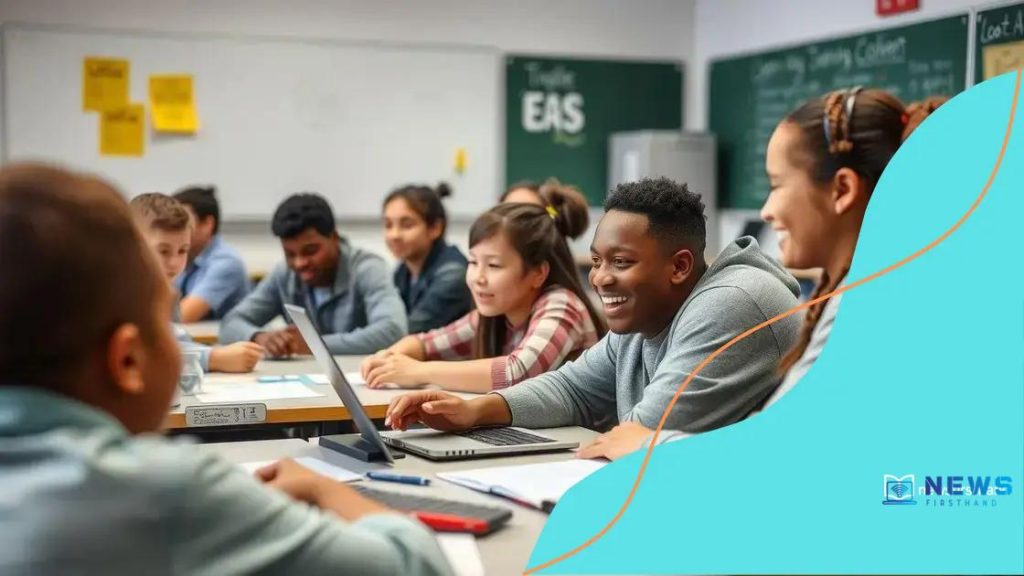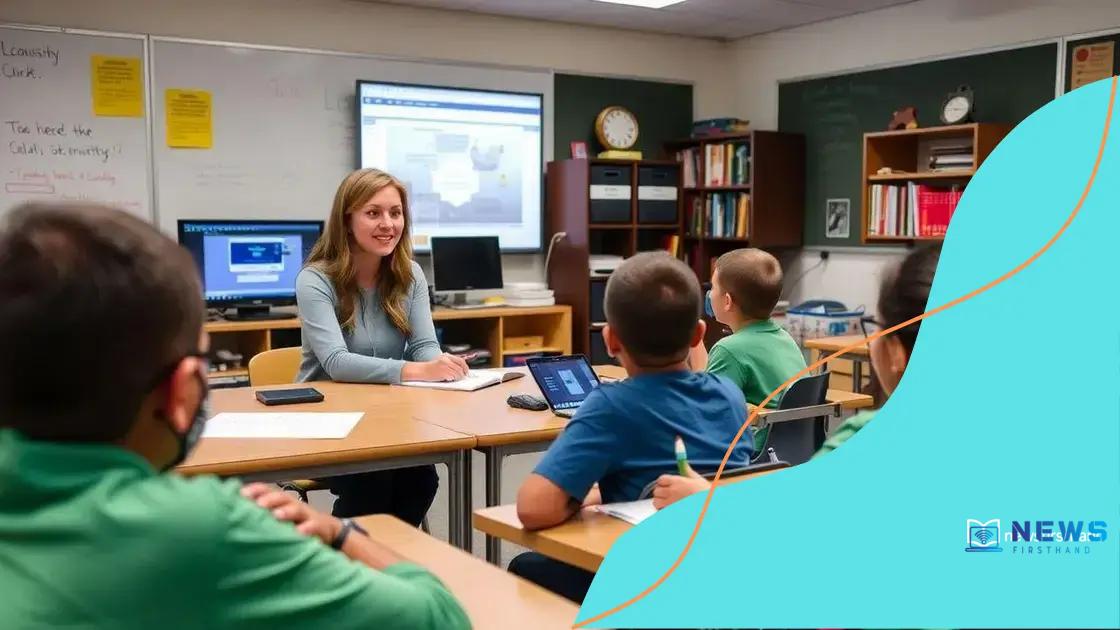Pandemic learning loss solutions: bridging the gap

Effective strategies for addressing pandemic learning loss include targeted remediation, incorporating technology, and providing social-emotional support to help students recover and thrive academically.
Pandemic learning loss solutions are essential as students face unprecedented setbacks. Have you noticed how educational gaps have widened since the pandemic? Let’s dive into strategies that can help bridge this gap and support students.
Understanding pandemic learning loss
Understanding pandemic learning loss is crucial for addressing the educational setbacks experienced by students during the COVID-19 crisis. Schools were forced to adapt rapidly, leading to various challenges in effective learning. Many students faced disruptions in their education, which contributed to learning gaps.
To better grasp this issue, it’s essential to explore the key factors behind these losses. For instance, remote learning posed difficulties for countless students, including limited access to technology and a lack of effective engagement.
Key factors contributing to learning loss
Recognizing these factors helps educators develop targeted solutions. Here are some of the main reasons:
- Limited access to reliable internet and devices
- Insufficient training for teachers on online instruction
- Increased distractions at home
- Social-emotional challenges affecting students’ focus
Moreover, the impact of the pandemic varies across demographics. Underprivileged students, in particular, experienced more significant learning loss than their peers. This inequality highlights the need for equitable solutions in the recovery process.
As we analyze the situation, it becomes clear that understanding pandemic learning loss requires a comprehensive view of the challenges and the varied experiences of students. The data collected can guide educators in crafting effective interventions tailored to specific needs.
Moving forward
Addressing this learning loss is not merely about catching up on missed curriculum. It involves creating inclusive educational environments where all students can thrive. Schools should focus on building supportive systems that recognize individual circumstances.
In essence, understanding pandemic learning loss is a beacon for educators aiming to enhance recovery strategies.
The impact of COVID-19 on education
The impact of COVID-19 on education has been profound and widespread. As schools closed their doors, millions of students faced unexpected hurdles in their learning journeys. This unprecedented situation introduced significant challenges for both students and educators, changing the landscape of education as we know it.
Many learners struggled to adapt to remote learning environments. Access to technology was a key issue. Not all students had reliable internet or devices at home, creating a digital divide that hampered their ability to participate in online classes.
Key impacts on students
Students have experienced various effects due to the shift caused by the pandemic. Some of the most significant impacts include:
- Increased learning gaps due to inconsistent instruction
- Challenges with motivation and engagement in virtual settings
- Social isolation from peers affecting emotional well-being
- Heightened stress and anxiety related to uncertain futures
The transition to online lessons also required educators to quickly adapt their teaching methods. This was especially challenging for teachers who were not familiar with digital tools. They needed to innovate rapidly while ensuring students remained engaged and learning.
In addition, assessment methods changed dramatically. Standardized tests were postponed or canceled, leaving educators with little guidance on student progress. Deciding how to evaluate learning and provide appropriate support became increasingly complex.
Long-term effects
The long-term effects of COVID-19 on education could be felt for years to come. Schools must now focus on remediating learning losses while also catching students up on social skills. As students return to classrooms, rebuilding relationships and fostering a sense of community will be essential.
In this evolving landscape, recognizing the multi-faceted impact of COVID-19 on education is critical. Schools must address learning gaps while nurturing the emotional and social development of all students.
Effective strategies for remediation

Effective strategies for remediation are vital for helping students overcome learning gaps caused by the pandemic. As schools identify these gaps, it is important to adopt targeted approaches that cater to the diverse needs of students. Engaging students through personalized support is essential in creating a positive learning environment.
One effective method involves implementing small group instruction. By breaking students into smaller cohorts, teachers can address individual learning needs more effectively. This targeted approach allows for more interaction and tailored feedback.
Additional strategies for remediation
Schools can also incorporate several other strategies to enhance learning recovery:
- Utilizing formative assessments: Assessing students regularly can help identify specific areas where they need assistance.
- Incorporating technology: Online resources and interactive tools can provide engaging learning experiences and reinforce concepts.
- Establishing a mentorship program: Pairing students with mentors can help provide guidance and boost confidence.
- Fostering collaboration: Group projects and peer tutoring encourage interaction and support among students.
Another important aspect of remediation is addressing the social-emotional needs of students. Incorporating activities that promote well-being can help students feel more comfortable and motivated to learn. Teachers can create a safe classroom environment by encouraging open discussions and providing emotional support.
Moreover, involving parents and caregivers in the learning process is crucial. Keeping lines of communication open ensures that families understand how they can support their children at home. Providing resources and sharing strategies with families helps create a unified approach to student success.
Consistent monitoring and feedback
To ensure that remediation efforts are effective, it’s essential to monitor progress regularly. Teachers should provide students with consistent feedback that highlights their improvements and areas for growth. This ongoing communication not only helps students stay on track but also boosts their motivation to succeed.
Ultimately, implementing effective strategies for remediation requires a multi-faceted approach that prioritizes individualized support and fosters a collaborative learning environment.
Utilizing technology in learning recovery
Utilizing technology in learning recovery has become more important than ever. With the challenges faced during the pandemic, educational technology offers innovative solutions to support students’ needs. Integrating technology into the classroom can enhance engagement and provide personalized learning experiences.
One significant advantage of technology is the ability to access resources anytime and anywhere. Students can use online platforms and educational apps to reinforce their understanding of subjects. This flexibility allows them to learn at their own pace and revisit material as needed, providing an avenue for greater mastery.
Types of technological tools
There are various tools available that support learning recovery:
- Learning management systems: Platforms like Google Classroom and Moodle facilitate communication and organization, helping teachers streamline lesson planning and assignments.
- Educational apps: Programs like Khan Academy and Quizlet offer interactive content that makes learning fun while allowing students to practice skills in subjects like math and language arts.
- Virtual tutoring: Online tutoring services can connect students with educators or peers who provide additional support in specific subjects.
- Gamification: Using game-like elements in educational contexts can motivate students. Apps that incorporate challenges and rewards can enhance engagement and learning outcomes.
Moreover, technology can aid in tracking student progress. Teachers can utilize data analytics tools to collect and analyze performance metrics. This information helps in identifying areas where students struggle and tailoring instruction accordingly. Such data-driven decisions ensure that educators can provide targeted interventions to support individual student needs.
While technology offers numerous benefits, it is essential to combine it with traditional teaching methods. Integrating face-to-face interactions alongside technology promotes social connections among students. Educators should balance the use of technology with hands-on activities that encourage collaboration and critical thinking.
Using technology for social-emotional support
Additionally, technology can be utilized to promote social-emotional learning (SEL). Various platforms offer resources and activities that foster emotional intelligence, resilience, and relationship-building skills. Programs that encourage mindfulness and stress relief can be integrated into the daily routine to support students’ overall well-being.
In conclusion, utilizing technology in learning recovery offers unique opportunities for enhancing education. By employing a mix of tools and strategies, educators can better support their students and help them regain lost ground from the disruptions caused by the pandemic.
Promoting social-emotional support for students
Promoting social-emotional support for students is essential for their overall well-being and academic success. As classrooms evolve, especially post-pandemic, the focus on mental health and emotional skills has become increasingly important. Educators must foster environments that encourage students to express their feelings and build positive relationships.
One effective way to promote social-emotional learning is through structured programs that teach skills like empathy, self-regulation, and communication. These programs help students develop emotional intelligence, allowing them to navigate challenges in school and life.
Strategies for enhancing social-emotional support
Implementing various strategies can significantly enhance social-emotional support. Here are some effective methods:
- Mindfulness practices: Incorporating mindfulness activities, such as breathing exercises or meditation, can help students manage stress and improve focus.
- Positive reinforcement: Recognizing and rewarding positive behavior encourages students to engage with their peers in respectful and supportive ways.
- Open communication: Establishing a classroom culture where students feel safe to share their thoughts and feelings promotes trust and understanding among classmates.
- Conflict resolution training: Teaching students how to resolve conflicts peacefully helps them develop essential interpersonal skills.
In addition, teachers can create moments for social interaction through group activities or collaborative projects. These opportunities allow students to practice working together, enhancing their teamwork skills.
Equally important is the involvement of families in supporting students’ social-emotional health. Schools can provide resources and workshops for parents to understand the challenges their children face, enabling them to reinforce positive behaviors at home.
Building strong connections
Teachers play a key role in promoting social-emotional support by building strong relationships with their students. Taking the time to understand each student’s unique interests and challenges fosters a sense of belonging. Regular check-ins can signal to students that their feelings and experiences are valued.
Ultimately, a focus on social-emotional support enhances students’ learning experiences and contributes significantly to their growth and resilience.
In conclusion, addressing the challenges of pandemic learning loss requires a comprehensive approach that combines effective remediation strategies with a strong focus on social-emotional support. By harnessing technology, fostering positive relationships, and actively engaging families, educators can create nurturing environments where students thrive. These collective efforts not only help students catch up academically but also support their overall well-being, preparing them for future success.
FAQ – Frequently Asked Questions about Pandemic Learning Loss Solutions
What is pandemic learning loss?
Pandemic learning loss refers to the significant educational setbacks students faced due to school closures and disruptions caused by COVID-19.
How can technology help in learning recovery?
Technology provides access to educational resources, personalized learning experiences, and enables remote support for students who need additional help.
Why is social-emotional support important for students?
Social-emotional support helps students manage stress, build positive relationships, and improves their overall well-being, which is essential for effective learning.
What role do families play in supporting students’ learning?
Families can reinforce learning at home, stay informed about their children’s progress, and create supportive environments that encourage academic success.





